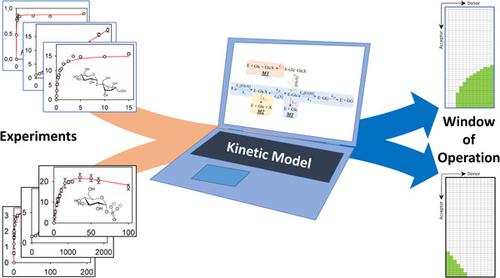当前位置:
X-MOL 学术
›
Biotechnol. Bioeng.
›
论文详情
Our official English website, www.x-mol.net, welcomes your feedback! (Note: you will need to create a separate account there.)
On the donor substrate dependence of group-transfer reactions by hydrolytic enzymes: Insight from kinetic analysis of sucrose phosphorylase-catalyzed transglycosylation.
Biotechnology and Bioengineering ( IF 3.8 ) Pub Date : 2020-06-23 , DOI: 10.1002/bit.27471 Mario Klimacek 1 , Alexander Sigg 1 , Bernd Nidetzky 1, 2
Biotechnology and Bioengineering ( IF 3.8 ) Pub Date : 2020-06-23 , DOI: 10.1002/bit.27471 Mario Klimacek 1 , Alexander Sigg 1 , Bernd Nidetzky 1, 2
Affiliation

|
Chemical group‐transfer reactions by hydrolytic enzymes have considerable importance in biocatalytic synthesis and are exploited broadly in commercial‐scale chemical production. Mechanistically, these reactions have in common the involvement of a covalent enzyme intermediate which is formed upon enzyme reaction with the donor substrate and is subsequently intercepted by a suitable acceptor. Here, we studied the glycosylation of glycerol from sucrose by sucrose phosphorylase (SucP) to clarify a peculiar, yet generally important characteristic of this reaction: partitioning between glycosylation of glycerol and hydrolysis depends on the type and the concentration of the donor substrate used (here: sucrose, α‐d‐glucose 1‐phosphate (G1P)). We develop a kinetic framework to analyze the effect and provide evidence that, when G1P is used as donor substrate, hydrolysis occurs not only from the β‐glucosyl‐enzyme intermediate (E‐Glc), but additionally from a noncovalent complex of E‐Glc and substrate which unlike E‐Glc is unreactive to glycerol. Depending on the relative rates of hydrolysis of free and substrate‐bound E‐Glc, inhibition (Leuconostoc mesenteroides SucP) or apparent activation (Bifidobacterium adolescentis SucP) is observed at high donor substrate concentration. At a G1P concentration that excludes the substrate‐bound E‐Glc, the transfer/hydrolysis ratio changes to a value consistent with reaction exclusively through E‐Glc, independent of the donor substrate used. Collectively, these results give explanation for a kinetic behavior of SucP not previously accounted for, provide essential basis for design and optimization of the synthetic reaction, and establish a theoretical framework for the analysis of kinetically analogous group‐transfer reactions by hydrolytic enzymes.
中文翻译:

关于水解酶的基团转移反应的供体底物依赖性:从蔗糖磷酸化酶催化的转糖基化的动力学分析中洞察。
水解酶的化学基团转移反应在生物催化合成中具有相当重要的意义,并在商业规模的化学生产中得到广泛利用。从机制上讲,这些反应共同涉及共价酶中间体,该中间体在酶与供体底物反应时形成,随后被合适的受体拦截。在这里,我们研究了蔗糖磷酸化酶 (SucP) 对蔗糖中甘油的糖基化,以阐明该反应的一个特殊但通常很重要的特征:甘油糖基化和水解之间的分配取决于所用供体底物的类型和浓度(此处为:蔗糖,α- d-葡萄糖1-磷酸(G1P))。我们开发了一个动力学框架来分析效果并提供证据表明,当 G1P 用作供体底物时,水解不仅来自 β-葡萄糖基酶中间体 (E-Glc),而且还来自 E-Glc 的非共价复合物和与 E-Glc 不同的底物与甘油无反应。取决于游离和底物结合的 E-Glc 水解的相对速率,抑制(肠系膜明串珠菌SucP)或表观激活(青春双歧杆菌)SucP) 在高供体底物浓度下观察到。在不包括底物结合的 E-Glc 的 G1P 浓度下,转移/水解比率变为与仅通过 E-Glc 进行的反应一致的值,与使用的供体底物无关。总的来说,这些结果解释了以前没有考虑过的 SucP 的动力学行为,为合成反应的设计和优化提供了必要的基础,并为分析水解酶的动力学类似基团转移反应建立了理论框架。
更新日期:2020-06-23
中文翻译:

关于水解酶的基团转移反应的供体底物依赖性:从蔗糖磷酸化酶催化的转糖基化的动力学分析中洞察。
水解酶的化学基团转移反应在生物催化合成中具有相当重要的意义,并在商业规模的化学生产中得到广泛利用。从机制上讲,这些反应共同涉及共价酶中间体,该中间体在酶与供体底物反应时形成,随后被合适的受体拦截。在这里,我们研究了蔗糖磷酸化酶 (SucP) 对蔗糖中甘油的糖基化,以阐明该反应的一个特殊但通常很重要的特征:甘油糖基化和水解之间的分配取决于所用供体底物的类型和浓度(此处为:蔗糖,α- d-葡萄糖1-磷酸(G1P))。我们开发了一个动力学框架来分析效果并提供证据表明,当 G1P 用作供体底物时,水解不仅来自 β-葡萄糖基酶中间体 (E-Glc),而且还来自 E-Glc 的非共价复合物和与 E-Glc 不同的底物与甘油无反应。取决于游离和底物结合的 E-Glc 水解的相对速率,抑制(肠系膜明串珠菌SucP)或表观激活(青春双歧杆菌)SucP) 在高供体底物浓度下观察到。在不包括底物结合的 E-Glc 的 G1P 浓度下,转移/水解比率变为与仅通过 E-Glc 进行的反应一致的值,与使用的供体底物无关。总的来说,这些结果解释了以前没有考虑过的 SucP 的动力学行为,为合成反应的设计和优化提供了必要的基础,并为分析水解酶的动力学类似基团转移反应建立了理论框架。


























 京公网安备 11010802027423号
京公网安备 11010802027423号